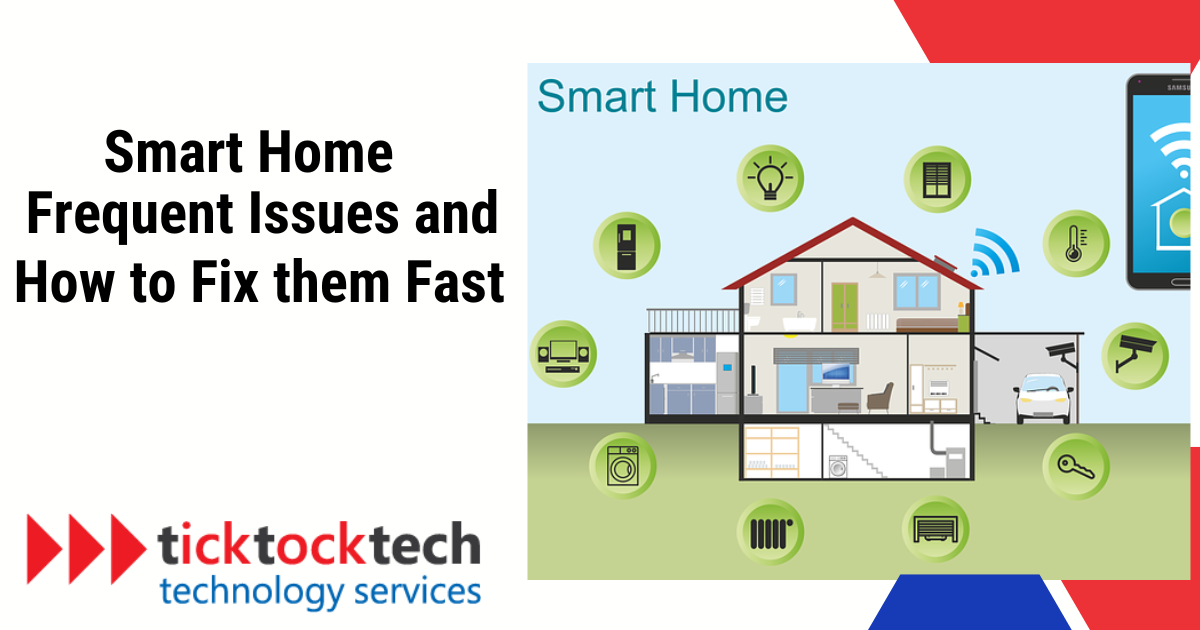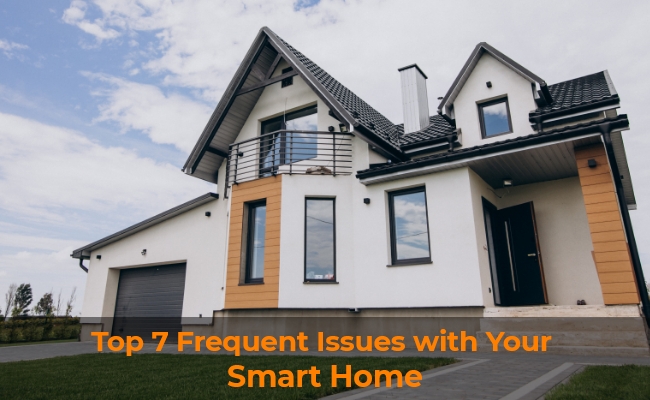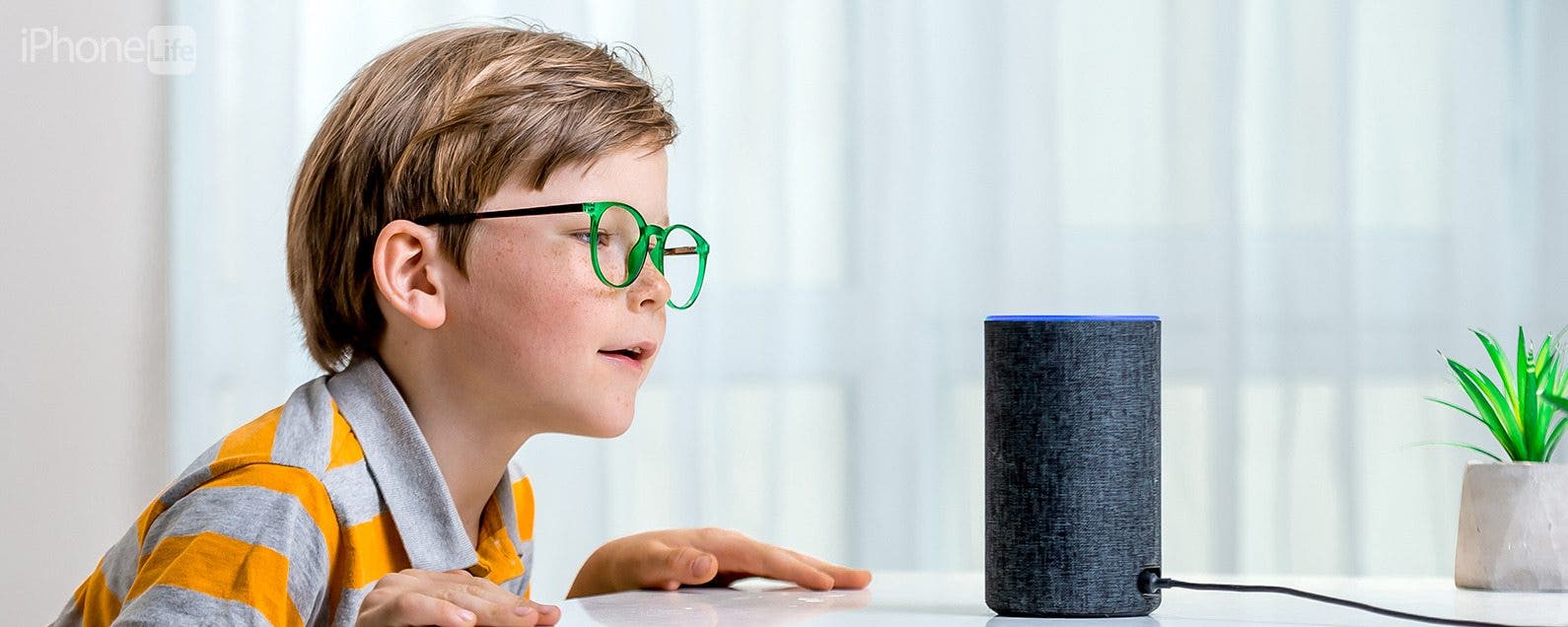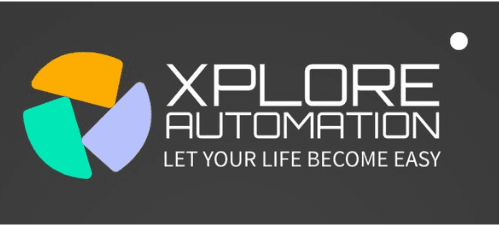Smart home frequent issues can include connectivity problems and device compatibility issues, which can hinder the seamless functioning of your smart home system. Welcome to the world of smart homes, where technology seamlessly integrates with our daily lives to offer convenience and efficiency.
From controlling the lights with a simple voice command to monitoring your home security remotely, smart homes are steadily becoming more popular. However, like any technology, smart home systems may encounter some common issues that can cause frustration and inconvenience.
We will explore some of the frequent issues faced by smart homeowners, such as connectivity problems and device compatibility issues. By understanding these challenges and exploring possible solutions, you can ensure a smooth and hassle-free experience with your smart home system.

Credit: ticktocktech.com
Slow Internet Connectivity
Slow internet connectivity is one of the most common issues faced in a smart home, often leading to frustration and inconvenience. When your devices take ages to connect or streaming becomes a buffer-filled nightmare, it’s time to tackle the problem head-on. Below, we’ll delve into a couple of factors that may be contributing to your slow internet speeds and provide solutions to help you optimize your smart home network.
Incorrect Wi-fi Configuration
In some cases, slow internet connectivity can be attributed to misconfigured Wi-Fi settings. This can manifest through issues such as using the wrong Wi-Fi channel, inadequate placement of the router, or outdated firmware. These problems can significantly impact the signal strength and overall performance of your smart home devices.
Interference From Other Devices
Another common culprit for sluggish internet connectivity is interference from other devices. Microwave ovens, cordless phones, and even neighboring Wi-Fi networks can disrupt the signal, leading to reduced speeds and connectivity issues. Identifying and mitigating these sources of interference is essential for optimizing your network performance.
Device Compatibility Issues
When setting up a smart home, one of the common challenges faced by homeowners is device compatibility issues. These issues can potentially hamper the seamless functioning of a smart home and can range from incompatibility with the smart home hub to inconsistent firmware updates. Let’s take a closer look at each of these issues and how they can impact your smart home experience.
Incompatibility With Smart Home Hub
One primary source of device compatibility issues in a smart home setup can be the incompatibility between the devices and the smart home hub. A smart home hub acts as a central control unit for all the connected devices, allowing them to communicate and work together efficiently. However, not all devices are compatible with all smart home hubs.
For instance, if you have a specific smart home hub model and want to integrate a new device into your setup, you must ensure that the device you’re considering is compatible with your hub. Otherwise, you may face challenges in connecting the device or accessing its features through the hub.
Incompatibility issues can be particularly frustrating when you invest in a new device, only to find out later that it doesn’t work seamlessly with your existing smart home system. Therefore, it’s crucial to thoroughly research and check the compatibility specifications before adding a new device to your smart home network.
Inconsistent Firmware Updates
Another common device compatibility issue in smart homes arises from inconsistent firmware updates. Firmware updates play a crucial role in fixing bugs, enhancing performance, and adding new features to smart devices. However, the frequency and reliability of these updates can vary significantly across different brands and models.
Some manufacturers regularly release firmware updates to keep their devices up-to-date with the latest technology and security measures. On the other hand, other brands may have less frequent updates or even stop providing updates altogether after a certain period.
This inconsistency in firmware updates can create compatibility problems in a smart home setup. For example, a device may require a specific firmware version to be compatible with other devices or the smart home hub. If the device manufacturer fails to provide the necessary firmware updates, it can limit the functionality and compatibility of the device within the smart home ecosystem.
When purchasing smart devices for your home, it’s crucial to consider the device manufacturer’s track record when it comes to firmware updates. Look for brands that provide regular updates and have a good reputation for supporting their products in the long term.
In conclusion, device compatibility issues, such as incompatibility with the smart home hub and inconsistent firmware updates, can hinder the seamless functioning of a smart home. Being aware of these issues and taking proactive measures to ensure compatibility can help you build a reliable and efficient smart home setup.
Security And Privacy Concerns
In this era of interconnected devices, smart homes have become increasingly popular. However, along with the convenience they offer, there are also valid concerns surrounding the security and privacy of these interconnected systems. In this article, we will explore two significant aspects of security and privacy concerns in smart homes: vulnerabilities in smart home devices and data collection and sharing.
Vulnerabilities In Smart Home Devices
While smart home devices make our lives easier, they are not immune to vulnerabilities that could compromise our security. Hackers are relentless in their quest to exploit weaknesses and gain unauthorized access to our homes.
Some common vulnerabilities in smart home devices include weak passwords, outdated firmware, and insecure communication protocols. Using easily guessable passwords or failing to update device firmware can leave your smart home system open to exploitation. It is crucial to follow best practices such as using strong unique passwords and regularly updating device firmware to minimize these vulnerabilities.
Moreover, vulnerabilities can also arise from third-party apps and cloud platforms that integrate with smart home devices. It’s essential to choose reputable and trusted providers to minimize the risks associated with these integrations.
Data Collection And Sharing
Another significant concern in the world of smart homes is the collection and sharing of personal data. Smart home devices collect various types of data, including device usage patterns, energy consumption habits, and even camera recordings. This data is often stored on cloud servers or shared with third-party companies, raising valid privacy concerns.
While data collection can bring personalized experiences and improved device performance, it is essential to be aware of the data being collected and who has access to it. To safeguard your privacy:
- Review the privacy policies of smart home products and services to understand what data is collected and how it’s used.
- Ensure that you are comfortable with the level of data sharing involved in using the devices or services.
- Consider products and services that offer greater control over data sharing, such as allowing you to opt out of data collection or choose which data is shared.
- Regularly review and delete stored data that is no longer necessary.
By taking these steps, you can have better control and peace of mind over the data collected by your smart home devices, minimizing your exposure to potential privacy risks.

Credit: reolink.com
Integration Challenges
Integration challenges are a common occurrence in smart homes and can greatly hinder the seamless operation of interconnected devices. From difficulty in connecting different smart home devices to limited cross-platform compatibility, these issues pose significant hurdles that smart home users often encounter.
Difficulty In Connecting Different Smart Home Devices
Smart home systems often face hurdles in connecting different devices, especially those from different manufacturers. This can lead to incompatibility issues, making it difficult to achieve a cohesive and integrated experience across the various components of the smart home ecosystem.
Limited Cross-platform Compatibility
One of the primary integration challenges in smart homes revolves around the limited cross-platform compatibility. This issue arises when smart home devices operate on different protocols or standards, hindering their ability to communicate effectively with each other. As a result, users may encounter difficulties in creating unified and interconnected functionalities across their smart home devices.
Reliability And Performance Problems
Homes that are equipped with smart technology offer convenience and efficiency. However, they are not without their share of challenges. Reliability and performance problems can sometimes arise, causing frustration and inconvenience for homeowners. In this post, we will delve into two common issues: Device Malfunctioning and Unresponsiveness and Unreliable Voice Recognition.
Device Malfunctioning And Unresponsiveness
One of the most frustrating issues that smart homeowners may encounter is device malfunctioning and unresponsiveness. Imagine trying to turn on the lights, only to find that the smart switch is not working. This can happen due to various reasons such as network connectivity problems, software glitches, or hardware failures.
The way smart home devices are interlinked can contribute to reliability issues. When a single device malfunctions, it can impact the functioning of other connected devices as well. This interconnectedness can be a blessing and a curse, as it offers seamless automation but also increases the chances of problems.
To troubleshoot device malfunctioning and unresponsiveness, it is essential to ensure that all devices are properly connected to the network and have the latest firmware updates. Restarting the devices or performing a factory reset can also help resolve the issue in some cases. Additionally, reaching out to the manufacturer’s support team for guidance can be beneficial.
Unreliable Voice Recognition
Voice-controlled smart home devices have gained popularity in recent years, but they are not immune to reliability issues. Unreliable voice recognition can occur when the system fails to accurately comprehend voice commands or misinterprets them.
This problem can be especially frustrating when trying to control multiple devices simultaneously, as errors in voice recognition can lead to incorrect actions. For example, saying “Turn off the living room lights” may result in the bedroom lights being switched off instead.
To improve voice recognition reliability, it is advisable to provide clear and concise commands. Avoid using ambiguous phrases or speaking too quickly, as it may confuse the system. Regularly updating the voice recognition software and improving the system’s language model can also enhance accuracy.
Overall, while smart homes offer convenience and automation, it is crucial to be aware of potential reliability and performance issues. Being proactive in troubleshooting and maintaining the devices can help minimize these problems and ensure a smoother and more enjoyable smart home experience.

Credit: www.iphonelife.com
Frequently Asked Questions Of Smart Home Frequent Issues
What Are The Problems With Smart Home Devices?
Smart home devices come with their fair share of problems. These include security vulnerabilities, privacy concerns, compatibility issues, and potential technical glitches. Users should remain vigilant and take appropriate measures to protect their personal information and ensure a smooth user experience.
What Are the Negative Effects Of Smart Homes?
The negative effects of smart homes include privacy concerns, security vulnerabilities, potential hacking risks, overreliance on technology, and increased energy consumption.
Why Is My Smart Home Not Working?
If your smart home is not working, check if all the devices are properly connected and powered on. Ensure your internet connection is stable and try restarting the devices. For more help if the issue continues, get in touch with the manufacturer’s customer service.
What Are The Threats Of Smart Home?
Smart homes face threats such as hacking, privacy breaches, and data misuse, putting users’ personal information and safety at risk.
Conclusion
Addressing common smart home issues can enhance your overall home experience. By troubleshooting problems with connectivity, compatibility, and security, you can ensure a smoother and more reliable smart home environment. With the right approach and solutions, you can fully embrace the convenience and benefits of smart technology in your daily life.

I am a technology writer and blogger with 17 years of experience in the fields of information technology, artificial intelligence, cyber security, automated systems, and the latest technology trends.

